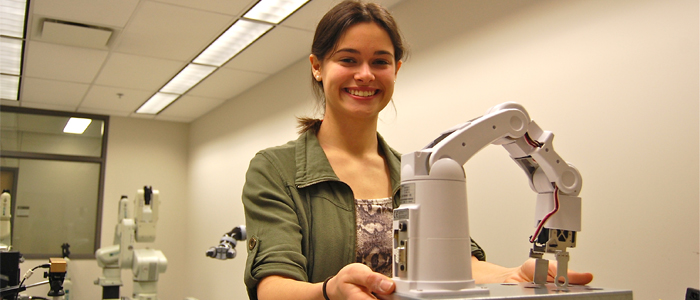Media
Contact
Communications Specialist
Faculty of Engineering
Spencer Engineering Building
Room 2072
Western University
Tel: 519-661-2111 ext. 87015
Email: engineeringcomms@uwo.ca
Robotics research rivets undergraduate student

Western Engineering News | January 27, 2015
By Jason Teakle
Andrea Zagar is on the leading edge of robotics research after seeking opportunities outside the purview of many undergraduate students.
The third-year Software Engineering student is working on the Remote Access to Laboratory Mechatronics (REALM) project supervised by Electrical and Computer Engineering Chair Ken McIssac.
The project is run by SHARCNET, a group of Canadian academic institutions that share a network of high-performance computers, and focuses on opening remote access to specialized laboratory teaching equipment for other universities. The technology allows schools to access and perform the same types of laboratory activities conducted at Western – without the cost of developing new labs.
“We typically think of research projects as work for graduate students,” McIssac said. “However, research strictly understood requires novelty; a true contribution to knowledge. Andrea’s primary responsibility was to integrate one of our two robots into REALM through the Robot Operating System (ROS) interface. This required her to understand ROS quite thoroughly, figure out where it wasn’t working, and implement the technology we needed.”
McIssac said the task was a unique challenge and Andrea’s success is more than impressive.
“She may be the only person on Earth who knows how to integrate ROS with the specific robot she was working with. It is a tremendous achievement.”
After joining the project last year, Zagar has successfully programmed a robotic arm. The project aims to provide remote access to laboratory teaching equipment that can soon be shared with other universities to increase its frequency of use.
“Right now, I can remotely control the robotic arm through my laptop,” she said. “I can send it joint commands.”
The task was not easy and took a lot of trial and error to get it right.
“I had to mash code together using my own code and code I found online through my research,” explained Zagar. “I had to de-bug and tweak the code until I could get the functionality I wanted out of it. It was a big conversion.”
As Zagar’s work wraps up, she will provide SHARCNET with the messages it needs to operate the newly-programmed robotic arm.
Working on the project has helped Zagar narrow down the field she would like to work in following her time at Western Engineering.
“This project has helped broaden my horizons because I didn’t realize how fun robotics is until I started working on it,” she said.
Research projects that allow for exposure to new fields of engineering keep Zagar on the edge of her seat.
“It is a never-ending puzzle and that it why I enjoy it so much,” said Zagar.
McIssac said though it is rare for undergraduates to be part of research projects, Western Engineering is the right place for undergraduates to join research teams.
“Western’s small size means that these kinds of opportunities for undergraduates are much more common here than at other, larger engineering faculties,” he said. “I believe this is an area in which we can lead.”

